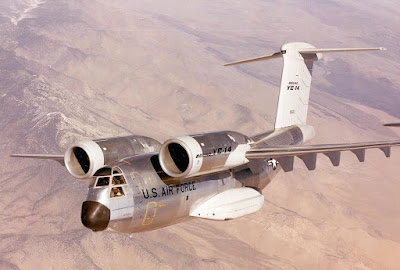. . . it’s how this plane flies.
The Coandă effect (named for its discoverer) is the way in which a jet of air (or, for that matter, water) will travel over the surfaces adjacent to it, whether they’re straight or curved. This allows an aircraft utilizing the effect to direct air from its engines across the curved surface of its wing, providing greater lift at low speeds, which in turn shortens the takeoff and landing speed significantly.
The 1970’s experimental Boeing YC-14 used the effect to . . . well, to good effect!
The Boeing’s competitor at the time, the McDonnell Douglas YC-15, went on to be developed into the very successful C-17 Globemaster III. Ironically, it became a Boeing aircraft when the latter company took over McDonnell Douglas in 1997. The YC-14 project was abandoned in the US, but appears to have inspired the (much smaller) Antonov An-72 and An-74 aircraft in what was then the Soviet Union. They achieved only moderate sales success, but it appears they may be making a comeback. A US company has just announced it will invest $150 million in Ukrainian manufacturer Antonov to restart production of the An-74.
Here’s two video clips of a commercial An-74 freighter landing, then taking off. Note the thrust reversers, which appear above the engine as the aircraft lands. Note, on takeoff, how the thrust from the engines flows over the top of the wings, providing greater lift by using the Coandă effect to best advantage.
Strange-looking bird, isn’t it? I’d like to see those high-mounted engines on some of the dirt airstrips I’ve used in Africa. I think they might offer a real advantage in terms of not ingesting dirt and rocks kicked up by the undercarriage . . . but I’m not so sure about low-flying buzzards over the runway!
Peter

A related phenomena is Wing In Ground Effect, were the induced drag on a body (esp. aircraft) drops dramatically when it's within about half a wingspan of a flat surface like the ground or sea.
Google the term for some fascinating pictures of "planes" designed to skim the sea at high speeds.
Wonder how bad the metal fatigue is with the engines that far forward and in the tail? Did you see the wobble in the tail as it was landing?
I was witness to the first flights of the YC-14. It took off in an amazingly short distance. But with such a design, the loss of an engine with flaps down, at low altitude, can be the start of a smoking crater. The lift one one wing would suddenly be greatly reduced and the aircraft would want to roll right over.
Yeah, I'd want 4 engines, for sure, just to minimize that. But thorough training and really fast-retracting flaps behind the engines ought to minize that.
Good flight control software might be able to detect that, and take action. Loathe though I am to put my faith in software…
You listen to nonsense and set aside any remaining shred of truth
They hid the IR signature under the kids table and nobody using binoculars can see your house!
BEST PART? They keep doing that bs up to this day about everything.
Huh?….
Good candidate for Floats too.
Saw them more than once at Juba in South Sudan, also a couple times at Yida, a dirt airstrip in northern South Sudan. They did dirt and austere strips pretty well as far as I could tell.
I seem to recall seeing one of those at the Davis-Monthan AMARC yard. They try to preserve one of everything sent there for scrapping.
And the Pima museum in Tucson has the other one. So I've seen them both.
The forward section of the YC-14 bears a remarkable resemblance to the earliest version of the C-130 Hercules, with a nose profile described as a 'Roman Nose'.
Source info is from the book titled, 'Herc, hero of the skies'. I cannot recall the author's details but they're not hard to find. A very worth wile read.
I first heard about the Coanda effect in a lecture about flare stacks in oil refineries. They used it to help prevent flameouts and promote efficient combustion.
I first heard about it in a book by "Lee Correy" (G. Harry Stine) back in the 1980s as an explanation of how the book's aircars functioned.
In those pre Internet days, I wasn't sure if it was something real (if not practical) or pure handwavium to let him get on with the story.
So, real. Still dubious about flying cars, though.
I would think that the CL-415 water bomber has its engines on the top of its wings to use this.